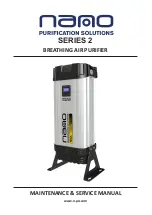
105
PB
R-410A SEALED SYSTEM REPAIR
Refrigerant Charging
WARNING
RISK OF ELECTRIC SHOCK
Unplug and/or disconnect all electrical power
to the unit before performing inspections,
maintenances or service.
Failure to do so could result in electric shock,
serious injury or death.
WARNING
RISK OF ELECTRIC SHOCK
Unplug and/or disconnect all electrical power
to the unit before performing inspections,
maintenances or service.
Failure to do so could result in electric shock,
serious injury or death.
Proper refrigerant charge is essential to unit operation. Operating a unit with an improper refrigerant charge will result in
reduced performance (capacity) and/or efficiency. Accordingly, the use of proper charging methods during servicing will
insure that the unit is functioning as designed and that its compressor will not be damaged.
Too much refrigerant (overcharge) in the system is just as bad (if not worse) than not enough refrigerant (undercharge).
They both can be the source of certain compressor failures if they remain uncorrected for any period of time. Quite often,
other problems (such as low air flow across evaporator, etc.) are misdiagnosed as refrigerant charge problems. The
refrigerant circuit diagnosis chart will assist you in properly diagnosing these systems.
An overcharged unit will at times return liquid refrigerant (slugging) back to the suction side of the compressor
eventually causing a mechanical failure within the compressor. This mechanical failure can manifest itself as valve
failure, bearing failure, and/or other mechanical failure. The specific type of failure will be influenced by the amount of
liquid being returned, and the length of time the slugging continues.
Not enough refrigerant (undercharge) on the other hand, will cause the temperature of the suction gas to increase to
the point where it does not provide sufficient cooling for the compressor motor. When this occurs, the motor winding
temperature will increase causing the motor to overheat and possibly cycle open the compressor overload protector.
Continued overheating of the motor windings and/or cycling of the overload will eventually lead to compressor motor or
overload failure.
Summary of Contents for VRP12K
Page 46: ...46 OPERATION Component Identification Indoor Coil 36k ...
Page 48: ...48 OPERATION Component Identification Outdoor Coil Monitored by 1 thermistor ...
Page 49: ...49 OPERATION Component Identification Outdoor Fan BLDC Variable Speed 600 1000 RPM ...
Page 53: ...53 OPERATION Component Identification 4 Way Reversing Valve 208 230v Reversing valve assembly ...
Page 177: ...177 UPDATING VRP FIRMWARE Or ...
Page 184: ...184 UPDATING VRP FIRMWARE Open zip file Copy to SD Card Insert into SD Card Slot ...
Page 193: ...193 UPDATING VRP FIRMWARE Retrieving VRP Data Remove SD Card from FMC and Locate DF Folder ...
Page 196: ...196 WIRINGDIAGRAMS 12 24K BTU 208 230V 7 5 10 0 KW Figure 801 Wiring Diagram ...
Page 197: ...197 WIRING DIAGRAMS 12 24K BTU 208 230V 2 5 3 4 5 0 KW Figure 802 Wiring Diagram ...
Page 198: ...198 WIRING DIAGRAMS 12 24K BTU 265V 2 5 3 4 5 0 kW Figure 803 Wiring Diagram ...
Page 199: ...199 WIRING DIAGRAMS 12 24K BTU 265V 7 5 10 kW Figure 804 Wiring Diagram ...
Page 200: ...200 WIRING DIAGRAMS 36K BTU 208 230V Figure 805 Wiring Diagram ...
















































